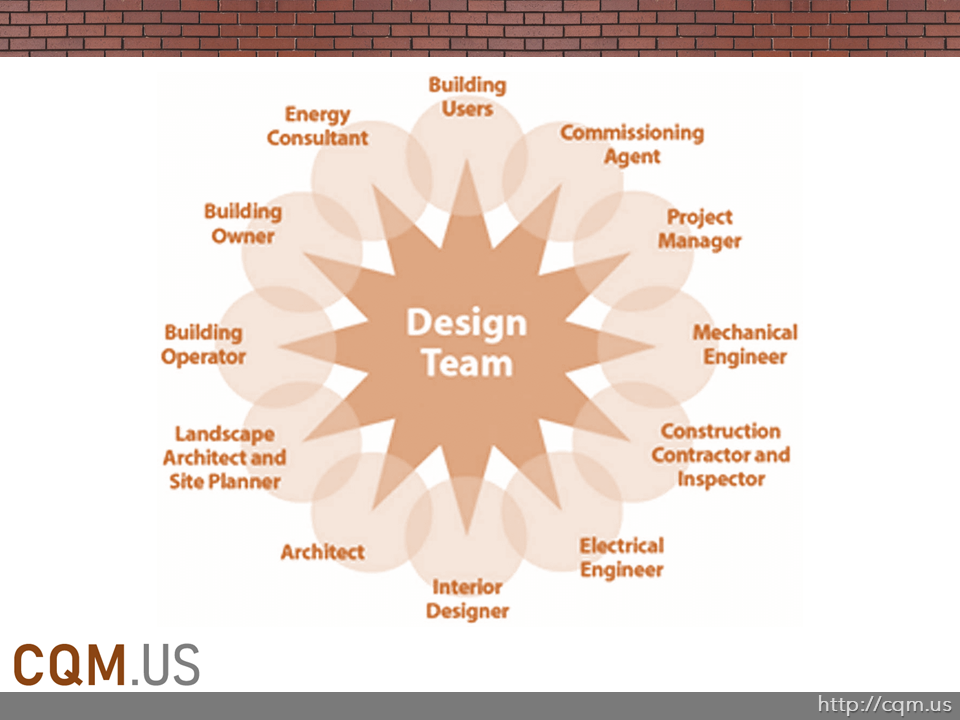
Integrated Project Team is necessary to maximize opportunities for cost-effective integrative design and construction strategies. Integrated Design charrettes are a great tool and method to engage SMEs in the design development phase, preferably during schematic design, and conduct periodic full-day workshops with the project team. Use the workshop to integrate sustainability strategies across all aspects of the building design, drawing on the expertise of all participants. The CQM team must assemble and involve a project team to meet the three criteria below:
a) Include team members whose capabilities include at least three of the following skill sets:
- architecture or residential building design;
- mechanical or energy engineering;
- building science or performance testing;
- green building or sustainable design; and
- civil engineering, landscape architecture, habitat restoration, or land-use planning.
b) Involve all team members referenced above in at least three of the following phases of the home design and construction process:
- conceptual or schematic design;
- LEED planning;
- preliminary design;
- energy and envelope systems analysis or design;
- design development;
- the final design, working drawings, or specifications; and
- construction.
c) Meet with the project team at least monthly to review project status, introduce new team members to project goals, discuss problems, formulate solutions, review responsibilities, and identify next steps.
CQM Expert as Charrette Facilitator
Integrated Design Charrettes provide an opportunity for unencumbered ideas to flow. The importance of a third-party facilitator is to encourage all ideas, distilling their essence while filtering freeform brainstorming from derailing the agenda. A professional CQM will inspire the attendees to have a system-thinking approach and provide facts that can root the idea in translating it to requirements and expectations for project implementation. When off-topic questions or those requiring additional research arise, write them down in a “parking lot” or “bike rack” of ideas that need further exploration.
- Remain as neutral as possible. It is necessary to separate yourself from any message so the group trusts your leadership.
- Translate the ideas of those less familiar with design into the language of the professional participants and vice versa to validate each concept and increase the likelihood that the attendees understand it.
- Ask more than you tell. Ask facilitative questions like:
- What specific outcomes or results do we want to accomplish?
- Can you expand on that? How would you summarize that point?
- Where’s the common ground? Can we take that as an agreement and move on?
- How are we doing? What course corrections do we need to make?
- What should I be doing more or less to be more effective?
- What would be the best use of our time right now?
- Document all ideas for everyone to see and add new topics to a “bike rack” for future research.
- Manage the agenda closely so that the meeting achieves the necessary closure. Remind presenters of the time remaining for their section.
- Keep the group on task by redirecting off-topic conversations to the current topic.
- Invite everyone to share ideas. If someone is quiet, ask their opinion so that all sides of view are represented.
- Be flexible. If the group needs to discuss an item not on the agenda, say, “Okay, it sounds like this topic is important. Do we want to continue this discussion or move it to the parking lot?”
- Get comfortable with mitigating conflict. Contrarians are invaluable to an effective process and acknowledge the contributions of participants.
- Repeat questions so everyone in the room can hear and bounce the question back to the entire group – thereby facilitating the group process. Remember, the group has the answers – you are not required to know everything.
CQM Experts Benchmark Best Practices
The most effective approach to planning for and understanding the potential outcomes of a charrette is to view reports from other diverse charrettes. The following charrette reports are available in A Handbook for Planning and Conducting Charrettes for High-Performance Projects . More information here:
- Boston National Historic Park Greening Charrette
- UNC – Asheville Greening Charrette
- Greenprints Charrette, Southface Energy Institute
- NCSU High-Performance Charrette College of Design
- Simon Fraser UniverCity Charrettes
Three other charrette reports are listed below:
- Eastern Carolina University New Dormitory Building
- Naval Support Activity Mid-South Base
- Southface Energy Institute New Office Building
Please follow and like us: